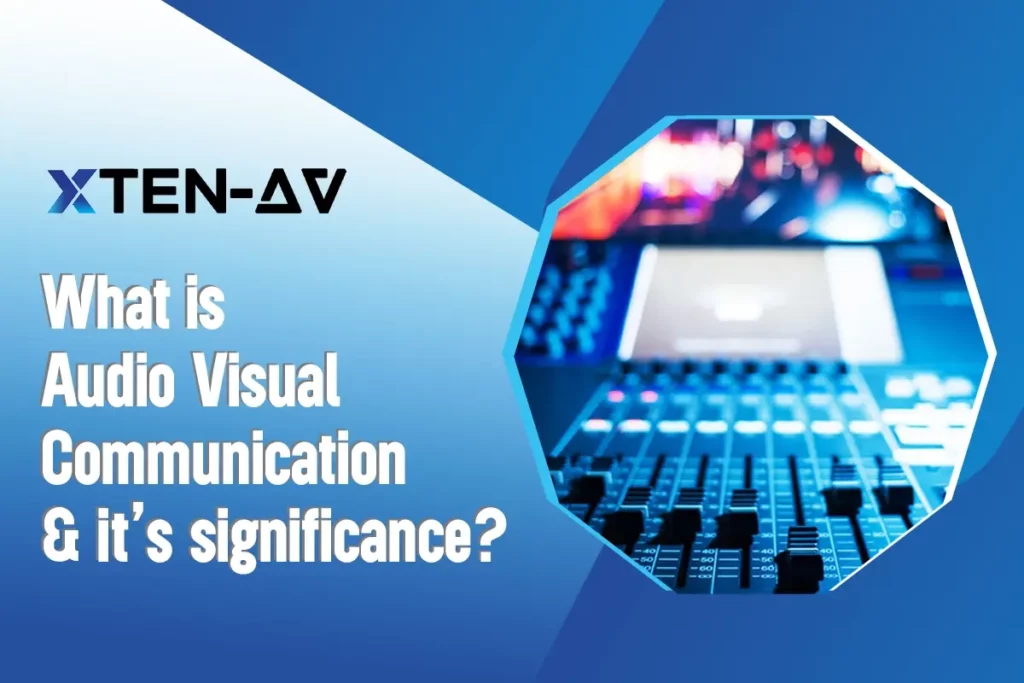What is Audio Visual Communication? Primary Components & Significances
Audio visual communication combines the power of sound and visual elements to create a dynamic and engaging method of conveying information. This form of communication is crucial in today’s technology-driven world, as it enhances understanding and retention by stimulating many senses. Whether used in corporate meetings, educational environments, healthcare, or entertainment, AV communication employs various tools, including projectors, microphones, video conferencing systems, and interactive whiteboards. The versatility and effectiveness of AV communications make it an invaluable tool for bridging geographical gaps, fostering collaboration, and ensuring that messages are delivered.
Key Takeaways
- Audio visual communication enhances audience engagement by combining auditory and visual elements for more impactful interactions.
- Utilizing audio visual multimedia formats in AV communication improves information retention by stimulating many senses.
- Modern AV solutions like video conferencing systems and interactive displays ease seamless, real-time collaboration across geographical distances.
- AV communication’s versatility is evident in its applications across education, healthcare, corporate environments, and entertainment sectors.
- Features like AI-driven transcriptions and digital signage in AV communications enhance accessibility, inclusivity, and the communication experience.
What is Audio Visual Communication?
Audio visual communication refers to transmitting information using sound and visual components. This dynamic method enhances understanding and retention by engaging many senses. In presentations, educational settings, and corporate meetings, audio visual communication employs projectors, microphones, video conferencing systems, and interactive whiteboards. Integrating these technologies facilitates clearer, more impactful exchanges of ideas and data.
Another important aspect of audio visual communication is its ability to bridge geographical gaps, enabling real-time interaction and collaboration among participants in different locations. Advanced systems can also incorporate artificial intelligence for automated transcriptions and translations, further enhancing accessibility and efficiency. By combining auditory and visual elements, this form of communication improves clarity and supports diverse learning styles and preferences, making it a crucial component in modern information dissemination.
What Are The 6 Basic Components Of AV Communication?
When we talk about AV communication, the next thing that comes to our mind is what components it includes. Here, we have shared a list of audio visual equipment that can help you communicate better:
Audio and Video Conferencing Solutions
Real-time communication requires audio and video conferencing systems incorporating speakers, microphones, and high-definition cameras. Modern systems’ capabilities, such as virtual backdrops, auto-framing cameras, and noise cancellation, improve meeting quality. Advanced systems may also include AI-driven features like automatic transcriptions and language translation to provide accessibility and inclusion for a worldwide audience.
Digital Displays and Signage
Digital displays and signage are necessary for distributing information in various contexts, including public and business places. They show dynamic material, such as ads and real-time statistics, on high-resolution screens. These displays are flexible tools for communication since they are simple to update and change and have touchscreen audio visual technology that increases audience participation.
Video Walls
Video walls combine many screens to create a large, unified display. These installations are often used in control rooms, broadcast studios, and public venues to provide expansive and immersive visual experiences. Video walls can be configured in various sizes and shapes, offering flexibility in design. Advanced video wall solutions include features like bezel-less screens for seamless visuals and high brightness and contrast ratios to ensure visibility even in well-lit environments. Additionally, video walls can integrate real-time data feeds and interactive capabilities for enhanced functionality.
Video walls consist of many screens that merge to create a larger screen and a unified display. These installations are often used for large events, control rooms, and broadcast studios.
Interactive Displays
Interactive displays combine touch technology with high-resolution screens to create engaging and interactive user experiences. Used in educational settings and corporate environments, these displays support activities such as collaborative brainstorming, interactive presentations, and digital whiteboarding. Advanced interactive displays come equipped with multi-touch capabilities, allowing many users to interact. They also support various input methods, including styluses and gesture recognition, making them versatile tools for enhancing communication and collaboration.
Audio Enhancement Technology
Audio enhancement technology is critical in ensuring clear and intelligible sound during audio visual communication. This AV technology includes tools like microphones, speakers, amplifiers, and soundbars designed to capture and deliver high-quality audio. Advanced audio enhancement systems feature technologies such as beamforming microphones, which focus on the speaker’s voice while minimizing background noise, and acoustic echo cancellation to prevent feedback. These innovations ensure that every participant can communicate regardless of the environment.
AV Control Systems
Control systems are the backbone of integrated AV communication setups, allowing users to manage various components from a centralized interface. These audio visual control systems can control lighting, audio, video, and environmental settings, streamlining the operation of complex AV systems. Modern control systems often include touch panels, mobile apps, and voice control options for intuitive management. Advanced features like automation and scheduling enhance efficiency, enabling seamless transitions between different presentation modes and environments. These systems ensure a smooth and effective AV experience by providing comprehensive control.
What Is the Impact and Significance of AV Communication?
Professionally designed AV communication solutions offer many benefits, including higher audience engagement, improved information retention, strengthened brand and emotional connections, enhanced experiences, and extended reach. For more insights, check out our article on the power of audio and video communication here.
Improved Information Retention
People tend to grasp information better when presented in audio visual multimedia format. AV communication leverages this advantage to ensure that messages and content are memorable. AV presentations solidify key concepts and enhance memory retention by engaging many senses.
Strengthened Brand and Emotional Connections
AV communication is a powerful tool for fostering emotional connections. Combining visual storytelling, compelling audio, and interactive elements can evoke emotions. Leading to a deeper connection with the audience. This emotional engagement strengthens brand loyalty and creates a lasting impact.
Enhanced Experiences
Whether it’s an interactive training session or an educational presentation. AV communication enhances the experience. It makes the content fun and memorable, leaving a lasting impression on the audience. High-quality visuals ensure that participants engage and invest in the material.
Extended Reach
The digital nature of AV communication allows content to spread far and wide. Live streams and recorded sessions can reach audiences beyond geographical limitations. Ensuring that your message has a broader impact. This extended reach is crucial for businesses and organizations looking to engage with a global audience.
Technical, creative, and communication expertise are essential for the greatest impact. Producing quality AV multimedia content, operating AV equipment, selecting appropriate channels, and distributing content to audiences are critical factors in achieving results.
Applications of Audio Visual Communication
Audio visual (AV) communication technology has various applications across various sectors, enhancing communication, collaboration, and engagement. Here are some of the key applications:
Corporate and Business
In the corporate world, AV communications are vital for meetings, presentations, and conferences. Video conferencing systems enable remote teams to collaborate, reducing the need for travel and saving cost and time. High-quality presentations and digital signage are great for internal communications, marketing, and branding. Ensuring that the message reaches the audience.
Education
AV communication has transformed education by providing interactive and immersive learning experiences. Smart classrooms equipped with interactive whiteboards, projectors, and sound systems allow dynamic teaching methods. Online courses and virtual classrooms enable remote learning, making education accessible to students worldwide. Educational videos and audio visual media presentations enhance comprehension and retention of complex subjects.
Healthcare
In the healthcare sector, AV communication facilitates telemedicine, allowing doctors to consult with patients, conduct virtual follow-ups, and collaborate with other healthcare professionals. Video tutorials, live surgeries, and interactive webinars enhance training and education for medical staff, and informative videos and presentations improve patient education.
Entertainment and Media
The entertainment industry relies on AV communication for producing and distributing content. From movie theaters with high-definition projectors and surround sound systems to live concerts with video walls and advanced lighting, AV technology enhances the audience experience. Streaming services and video-on-demand platforms also use AV communication to deliver content to viewers around the world.
Retail
In retail, AV communication is used to create engaging and interactive customer experiences. Digital signage and video walls can display promotions, advertisements, and product information, capturing customers’ attention and influencing purchasing decisions. Interactive displays and kiosks provide customers with more information and a personalized shopping experience.
Government and Public Services
Government agencies and public services use AV communication for a variety of purposes, including public announcements, training, and emergency response coordination. Digital signage can display important information in public spaces, while video conferencing allows for efficient communication between different departments and locations. AV technology also supports virtual town hall meetings and public forums, enhancing citizen engagement.
Hospitality and Tourism
In the hospitality and tourism industry, AV communication enhances the guest experience through digital signage, interactive displays, and entertainment systems in hotels and resorts. Virtual tours and promotional videos attract visitors and provide them with valuable information about destinations. Conference facilities equipped with audio video technology enable seamless events and meetings for business travelers.
Houses of Worship
Houses of worship use AV communication to enhance services and outreach efforts. High-quality sound systems, projectors, and video screens improve the worship experience for congregants. Live streaming of services and events allows for broader community engagement, reaching individuals who cannot attend in person.
AV Design Mastery + Winning Proposals = 10x Productivity!
- Automatic Cable Labeling & Styling
- 100+ Free Proposal Templates
- Upload & Create Floor Plans
- 1.5M Products from 5200 Brands
- AI-powered ‘Search Sense'
- Legally Binding Digital Signatures
Conclusion
Audio visual communication combines the power of sound and visual elements to create a dynamic and engaging method of conveying information. This form of communication is crucial in today’s technology-driven world, as it enhances understanding and retention by stimulating many senses. Whether used in corporate meetings, educational environments, healthcare, or entertainment, AV communication employs a range of tools including projectors, microphones, video conferencing systems, and interactive whiteboards. The versatility and effectiveness of AV communication make it an invaluable tool for bridging geographical gaps, fostering collaboration, and ensuring that messages are delivered.
Frequently Asked Questions
AV communication enhances information retention by engaging many senses visual and auditory. This multisensory engagement helps to solidify concepts and make them more memorable, compared to text-based or auditory-only communication.
A high-quality video conferencing system includes high-definition cameras, microphones, speakers, and advanced features such as virtual backdrops, noise cancellation, and AI-driven automatic transcriptions and translations. These components work together to provide clear and effective communication.
AV communication benefits remote education by enabling interactive and immersive learning experiences. Tools like interactive whiteboards, projectors, and online collaboration platforms ease dynamic teaching methods, making remote learning engaging and accessible for students worldwide.
In healthcare, AV communication facilitates telemedicine, allowing for remote consultations, virtual follow-ups, and professional collaboration. It also enhances training and education for medical staff through video tutorials and live surgeries and improves patient education with informative videos and presentations.


